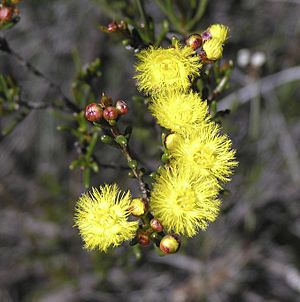Little chrysantha facts for kids
Quick facts for kids Little chrysantha |
|
|---|---|
 |
|
| Verticordia chrysanthella growing near Wongan Hills | |
| Scientific classification | |
| Genus: |
Verticordia
|
| Species: |
chrysanthella
|
Verticordia chrysanthella, also known as little chrysantha, is a beautiful flowering plant. It belongs to the myrtle family, called Myrtaceae. This plant is special because it only grows in the south-west part of Western Australia. It's a small shrub with unique cylinder-shaped leaves. Its flowers are a lovely lemon-yellow or gold color, and they change to orange, red, or brown as they get older.
Contents
What Verticordia chrysanthella Looks Like
Verticordia chrysanthella is a shrub that grows many branches from a single stem at its base. It can grow from about 0.10 m (0.3 ft) to 1.5 m (5 ft) tall. It can also spread out to about 1.0 m (3 ft) wide.
Its leaves are shaped like thin cylinders and are round when you look at them from the side. They are usually 3–8 mm (0.1–0.3 in) long and have a small hook at the very tip.
The Flowers
The flowers of Verticordia chrysanthella often have a nice smell. They grow in small groups at the ends of the branches. When they first open, they are bright lemon-yellow or golden-yellow. As they get older, their color changes to orange, red, or even brown.
Each flower stands up straight on a small stalk that is about 6–10 mm (0.2–0.4 in) long. The part of the flower that holds the petals and sepals, called the floral cup, looks like half a sphere. It's about 1.0–1.5 mm (0.04–0.06 in) long and is smooth, with a few small bumps.
The sepals are bright yellow and about 3.0–3.5 mm (0.12–0.14 in) long. They have 6 or 7 feathery parts. The petals are also bright yellow and about 3.0–3.5 mm (0.12–0.14 in) long. They have many long, finger-like parts that spread outwards. The style, which is part of the flower's reproductive system, is about 3.0–3.5 mm (0.12–0.14 in) long, straight, and smooth. This plant usually blooms from July to December.
How it Got its Name
The plant Verticordia chrysanthella was first officially described in 1991 by a scientist named Alex George. He wrote about it in a scientific journal called Nuytsia. He found the first examples of this plant near Wongan Hills with Elizabeth George.
The second part of its scientific name, chrysanthella, is a clue to what it looks like. It refers to another plant called Verticordia chrysantha. The ending "-ella" means "small" or "little," so chrysanthella means "little chrysantha."
Where it Grows and Lives
This type of verticordia plant usually grows in soil that comes from granite rocks. It often likes places that get wet during the winter, especially near granite rocks. You can often find it growing in groups with other types of verticordia plants. It lives in areas with heath (low-growing shrubs) and woodlands.
Verticordia chrysanthella is found in many places across Western Australia. You can see it from near the Murchison River in the north, all the way inland to places like Bonnie Rock and Holt Rock. It also grows south near Esperance.
Its Conservation Status
The Western Australian Government's Department of Parks and Wildlife has looked at Verticordia chrysanthella. They have decided that it is "not threatened." This means there are enough of these plants in the wild, and they are not currently in danger of disappearing.
Growing Verticordia chrysanthella
Verticordia chrysanthella is a very popular plant to grow in gardens and for plant lovers. It's probably the most commonly grown plant from its genus. People have successfully grown it in many parts of Australia and even in places like California. It can grow in different types of soil and climates.
You can start new Verticordia chrysanthella plants in a few ways:
- From seed.
- From cuttings, which are small pieces of the plant that can grow roots.
- By grafting, which means joining a piece of Verticordia chrysanthella onto the roots of another plant, like Darwinia citriodora.
This plant is great for planting many together to create a beautiful display. It also looks very attractive when grown in a pot.

